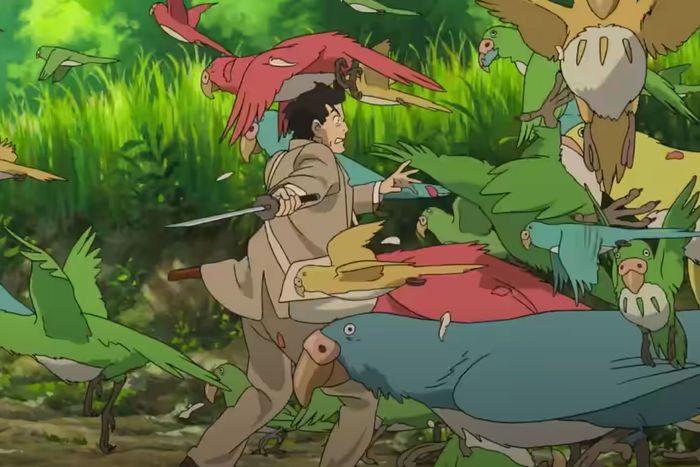
The Boy and the Heron is many things. It’s a capstone to Hayao Miyazaki’s career, pulling together themes and visuals from throughout his filmography into a masterpiece summation of his views on youth, adulthood, fascism, and grief. It’s a horror film about a haunted house and a grotesque avian gatekeeper to a land of the dead. It’s a silly film about hungry, hungry parakeets and weird little guys. It’s a devastating bit of catharsis as we witness the pain and loss required for a broken era to fall away.
It’s also covered in bird shit.
As the name of the movie suggests, The Boy and the Heron involves birds. A lot of them, actually. There’s the titular gray heron, a supernatural man in a bird’s skin who taunts Mahito, a young boy who has moved to the countryside following his mother’s death in a bombing of Tokyo. There are the pelicans who gobble up Warawara, the adorable little spirits inside the magical world the heron takes Mahito to. And there is an army of human-like, colorful parakeets who have taken to the taste of human flesh and developed a militaristic society. Despite the strange abilities of these fantastical birds of varying levels of anthropomorphism, they do what birds do. They poop.
The first major instance comes when Mahito, in bed recovering from an injury he inflicted on himself to get out of going to his new school, is visited by the gray heron. The bird grows distinctly un-bird-like teeth as it sits in his open window, taunting him with a request for his presence. It’s an eerie, unsettling scene that ends with an understated reveal: The heron has left an enormous trail of white bird shit on Mahito’s windowsill that trails all the way down the wall and even pools a little on the floor.
There are two more big poop scenes, both courtesy of the parakeets’ cloacas. Upon learning that his son and his new, pregnant wife, Natsuko, are missing, Mahito’s dad, Shoichi, gets his sword (as a man living in Imperial Japan does) and heads to rescue them from the mysterious tower where the entrance to that magic world is hidden. At the same time, inside the other realm, Mahito and a young girl with fire powers named Himi need to temporarily duck back through a door into reality to escape an armed parakeet horde. The pursuing parrots pour through the door and charge en masse towards Shoichi, who draws his sword. But without the magic of the tower, the creatures transform back into regular, harmless birds, and Shoichi is left unharmed, confused, and covered with poop.
Something similar happens during the grand, emotional climax when Mahito and Natsuko escape from the crumbling tower along with all the now-non-magical birds. As reunited loved ones hug and embrace, the birds poop all over them — a distraction none of them seem to mind or notice as the tears flow and Joe Hisaishi’s score swells.
There’s poop inside the tower, too. The painted backgrounds of the parakeets’ domain seem to be splattered with a thick layer of semi-calcified goop that almost certainly is bird shit. It’s unclear whether it’s from the time before the magic of the tower turned the parakeets into humanoid fascists or if they’ve constantly just been letting it drop anywhere.
All of this bird poop is clearly intentional. It’s not like the poop was just the consequence of a bunch of real birds doing what birds do. This is an animated film, so each splatter needed to be deliberately drawn. More than that, Miyazaki is famously attentive to details and prolific in his use of symbolism. So what’s to be made of all this bird poop?
Does Miyazaki just hate birds? We know he loves airplanes (they’re his problematic fav). Does he just prefer things that fly and don’t poop? Planes drop bombs, but at least they don’t drop a deuce? Seems unlikely. Maybe Miyazaki simply understands, correctly, that poop is very funny. The Boy and the Heron, despite being one of Miyazaki’s darkest films, is also quite amusing, full of quirky little beats and charmingly silly animation. The birds relieving themselves is comic relief.
While that’s a motivating factor behind all the poop, it’s probably not the only one — especially given the significance of birds in this movie and Miyazaki’s reverence for the natural world.
That appreciation of nature, reflected in films like Princess Mononoke and Nausicaä of the Valley of the Wind, encourages a more profound reading of all the poop. The Boy and the Heron is about many things, one of which is how necessary the end of Imperial Japan was, despite all the pain that involved. That theme is not subtle — the mythical meteor that powers this magical world landed in Japan during the Meiji Restoration, which marked the start of the Empire. Imperial Japan industrialized and westernized itself, imposed a brutal, unnatural order to maintain its empire, and waged a war that devastated its people.
Poop, meanwhile, is extremely natural. To paraphrase another seminal Japanese text, everybody does it. Far from the parakeets’ uncanny facsimile of fascism, shitting everywhere is what birds are supposed to do. Nature, in Miyazaki’s films, is to be regarded with awe, but it’s not perfect. It’s dangerous and messy. Giant boars and wolves will battle with samurai, poison gas and monstrous bugs inhabit postapocalyptic forests, and birds poop. That’s what nature is, and it’s beautiful. (And, also, funny.)

